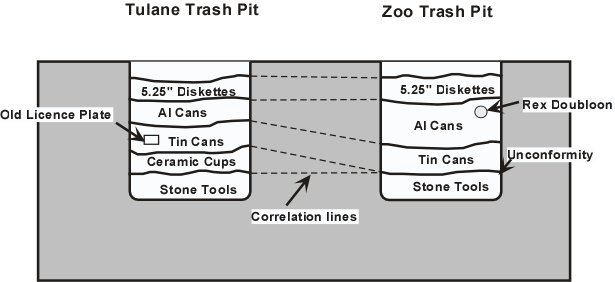
| EENS 1110 |
Physical Geology |
| Tulane University |
Prof. Stephen A. Nelson |
Geologic Time |
|
|
|
From the beginning of this course, we have stated that the Earth is about 4.6 billion years old. How do we know this and how do we know the ages of other events in Earth history? Prior to the late 17th century, geologic time was thought to be the same as historical time. The goal of this lecture is come to come to a scientific understanding of geologic time and the age of the Earth. In order to do so we will have to understand the following:
In order to understand how scientists deal with time we first need to understand the concepts of relative age and numeric age.
To better understand these concepts, let's look at an archeological example: Imagine we are a group of archeologists studying two different trash pits recently discovered on the Tulane University campus and at the Audubon Zoo (where they all aksed for you). By carefully digging, we have found that each trash pit shows a sequence of layers. Although the types of trash in each pit is quite variable, each layer has a distinctive kind of trash that distinguishes it from other layers in the pits. |
|
|
What can we say and learn from these excavations?
Notice that at this point we do not know exactly how old any layer really is. Thus we do not know the numeric age of any given layer.
In geology, we use similar principles to determine relative ages, correlations, and numeric ages.
|
Principles of Stratigraphy Stratigraphy is the study of strata (sedimentary layers) in the Earth's crust. Geologist in the 1800s worked out 7 basic principles of stratigraphy that allowed them, and now us, to work out the relative ages of rocks. Once these age relations were worked out, another principle fell into place - the principle of fossil succession. We discuss the 7 principles of stratigraphy first and then see how these apply to fossils. Principle of Uniformitarianism The principle of Uniformitarianism was postulated by James Hutton (1726-1797) who examined rocks in Scotland and noted that features like mudcracks, ripple marks, graded bedding, etc. where the same features that could be seen forming in modern environments. He concluded that process that are currently operating on the Earth must be the same processes that operated in the past. This principle is often stated as "the present is the key to the past". A more modern way of stating the same principle is that the laws of nature (as outlined by the laws of chemistry and physics) have operated in the same way since the beginning of time, and thus if we understand the physical and chemical principles by which nature operates, we can assume that nature operated the same way in the past. Principle of Superposition Because of Earth's gravity, deposition of sediment will occur depositing older layers first followed by successively younger layers. Thus, in a sequence of layers that have not been overturned by a later deformational event, the oldest layer will be on the bottom and the youngest layer on top. This is the same principle used to determine relative age in the trash pits discussed previously. In fact, sedimentary rocks are, in a sense, trash from the Earth's surface deposited in basins. Principle of Original Horizontality Sedimentary strata are deposited in layers that are horizontal or nearly horizontal, parallel to or nearly parallel to the Earth's surface. Sediment deposited on steep slopes will be washed away before it is buried and lithified to become sedimentary rock, but sediment deposited in nearly horizontal layers can be buried and lithified. Thus rocks that we now see inclined or folded have been disturbed since their original deposition.
|
Principle of Original Continuity If layers are deposited horizontally over the sea floor, then they would be expected to be laterally continuous over some distance. Thus, if the strata are later uplifted and then cut by a canyon, we know that the same strata would be expected to occur on both sides of the canyon. Look at the many photographs of the Grand Canyon in your textbook. Note that you can follow the layers all along the walls of the canyon, and you can find the same layers on both sides of the canyon. The Grand Canyon is particularly good for this because different sedimentary rocks have different colors. |
Principle of Cross-cutting Relations Younger features truncate (cut across) older features. Faults, dikes, erosion, etc., must be younger than the material that is faulted, intruded, or eroded.
|
|
| For example, the mudstone, sandstone and shale are cut by the basalt dike, so we know that the mudstone, sandstone, and shale had to be present before the intrusion of the basalt dike. Thus, we know that the dike is younger than the mudstone, sandstone, and shale. |
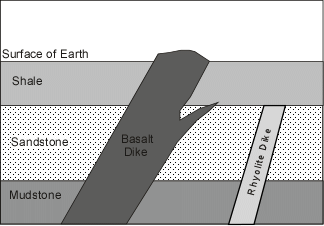 |
|
|
| In the diagram to the right,the fault cuts the limestone and the sandstone, but does not cut the basalt.
Thus we know that the fault is younger than the limestone and shale, but older than the basalt above. |
|
Principle of Inclusions
|
|
| In the example here, as the basalt flowed out on the surface it picked up inclusions of the underlying sandstone. So we know the sandstone is older than the basalt flow. | 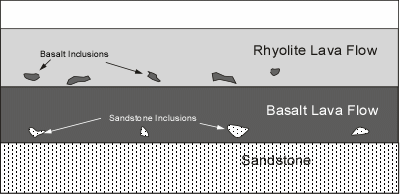 |
Similarly, the overlying rhyolite flow contains inclusions of the basalt, so we know that the basalt is older than the rhyolite. |
|
This principle is often useful for distinguishing between a lava flow and a sill. (Recall that a sill is intruded between existing layers).
In the case shown here, we know that the basalt is a sill because it contains inclusions of both the underlying rhyolite and the overlying sandstone. |
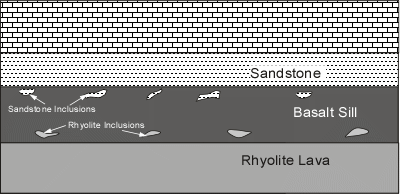 |
This also tells us that the sill is younger than the both the rhyolite and the sandstone. |
|
| Principle of Chilled or Baked Margins When a hot magma intrudes into cold country rock, the magma along the margins of the intrusion will cool more rapidly than the interior. |
|
| Rapid cooling of magma results in fine grained rock or glassy rock and if this occurs along the margins of the intrusion, we will see the effects of rapid cooling along the margins. Since slower cooling will occur farther away from the margin the rock farther away will be coarser grained. Thus, if we see chilled margins, we know that the intrusions must be younger that surrounding rock because the surrounding rock had to have been there first in order to cause the cooling effect. |
|
When magma comes in contact with soil or cold rock, it may cause the soil or rock to heat up resulting in a baked zone in the surrounding rock near the contacts with the igneous rock. Such margins indicate that the igneous rock is younger that the soil or rock that was baked. |
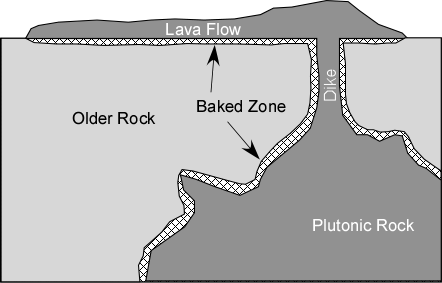 |
Figure 12.5 in your textbook shows a cross section of an imaginary sequence of rocks and shows how the geologic history of this sequence of rocks can be worked out by applying the principles of stratigraphy. Although we will go over this in lecture, you should study the methods and reasoning used so that you could determine the geologic history of any sequence of rocks. |
Fossil Succession Once geologists had worked the relative ages of rocks throughout the world, it became clear that fossils that were contained in the rock could also be used to determine relative age. It was soon recognized that some fossils of once living organisms only occurred in very old rocks and others only occurred in younger rocks. Furthermore, some fossils were only found within a limited range of strata and these fossils, because they were so characteristic of relative age were termed index fossils. With this new information, in combination with the other principles of stratigraphy, geologists we able to recognize how life had changed or evolved throughout Earth history. This recognition led them to the principle of fossil succession, which basically says that there is a succession of fossils that relate to the age of the rock.
|
|
Unconformities - Breaks in the Stratigraphic Record Because the Earth's crust is continually changing, i.e. due to uplift, subsidence, and
deformation, erosion is acting in some places and deposition of sediment is occurring in
other places. When sediment is not being deposited, or when erosion is removing
previously deposited sediment, there will not be a continuous record of sedimentation
preserved in the rocks. We call such a break in the stratigraphic record a hiatus
(a hiatus was identified in our trash pit example by the non-occurrence of the
Ceramic Cups layer at the Zoo site). When we find evidence of a hiatus in the
stratigraphic record we call it an unconformity. An unconformity is a
surface of erosion or non-deposition. Three types of unconformities are recognized.
|
|
Because of the Principles of Stratigraphy, if we see a cross section like this in a road cut or canyon wall where we can recognize an angular unconformity, then we know the geologic sequence of events that must have occurred in the area to produce the angular unconformity. Angular unconformities are easy to recognize in the field because of the angular relationship of layers that were originally deposited horizontally.
|
Nonconformity
|
|
Nonconformities occur where rocks that formed deep in the Earth, such as intrusive igneous rocks or metamorphic rocks, are overlain by sedimentary rocks formed at the Earth's surface. The nonconformity can only occur if all of the rocks overlying the metamorphic or intrusive igneous rocks have been removed by erosion.
|
Disconformity |
Disconformities are much harder to recognize in the field, because often there is no angular relationship between sets of layers. Disconformity are usually recognized by correlating from one area to another and finding that some strata is missing in one of the areas. The unconformity recognized in the Zoo trash pit is a disconformity. Disconformities can also be recognized if features that indicate a pause in deposition, like paleosols (ancient soil horizons), or erosion, like stream channels are present.
|
| Variation in Unconformities The nature of an unconformity can change with distance. Notice how if we are only examining a small area in the figure above, we would determine a different type of unconformity at each location, yet the unconformity itself was caused by the same erosional event. |
|
 |
Stratigraphic Formations and Their Correlation A Formation is a a rock or group of rocks that differ from rocks that occur above or below and have distinctive characteristics and fossils such that the rocks can be recognized over wide areas. Formations are given a formal name, normally a geographic locality. If it is a group of rocks, for example, interbedded sandstones and shales, then it might be called something like the Toroweap Formation. If it is a single rock type, then only the rock name is specified in the formation name, for example the Kaibab Limestone. If several formations can be grouped together as a distinctive set of formations, this called a Group. For example the Supai Group. |
|
Geologist often make a graphic to display stratigraphic information in an understandable way. Such a graphic, as shown above is a called a stratigraphic column. The column shows the relative thicknesses of each Formation or Group, the Formation Name, and gives an approximate idea of whether the rocks are hard- cliff forming units or softer more easily erodable units. People often say that rocks exposed in the Grand Canyon offer a complete record of geologic history, however this is incorrect. Note that there are several unconformities in the Grand Canyon Stratigraphic Column that represent gaps in the record. For example the Nonconformity near the bottom represent a gap of about 1.5 to 2 billion years. Nowhere on Earth is there a complete section that shows strata deposited over the entire history of the Earth. In the past, some areas were above sea level and being eroded and other areas were below sea level where deposition was occurring. Thus, in order to develop a complete record, correlations must be undertaken in order to see how everything fits together. Stratigraphic Correlation |
| In order for rock units to be correlated over wide areas, they must be determined to be equivalent. Determination of equivalence is based first on lithologic similarity. If the rock units have the same type of rocks and look similar then they may correlate. Sometime very distinctive rocks that don't change over large distances can be identified. These are referred to as key beds. Relative age must also be taken into account. If rocks are equivalent they must have the same relative age relationships to surrounding rocks in all areas. Finally, fossils, since they are key indicators of relative age as well as depositional environment, can be used to determine equivalence. |
|
The Geologic Column Over the past 150 years detailed studies of rocks throughout the world based on stratigraphic correlation have allowed geologists to correlate rock units and break them into time units. The result is the geologic column (on next page), which breaks relative geologic time into units of known relative age. Note that the geologic column was established and fairly well known before geologists had a means of determining numeric ages. Thus, in the geologic column shown below, the numeric ages in the far right-hand column were not known until recently. Large divisions are Eons - Oldest to Youngest are
These three units above are often referred to as the Precambrian.
The Eons are divided into Eras (only Phanerozoic Eras are shown in the chart). These include, from oldest to youngest:
|
|
|
The Eras are divided into Periods. The Periods are often named after specific localities. The Paleozoic Era has the following Periods:
The Mesozoic Era has the following Periods:
The Cenozoic Era has the following Periods:
Further subdivisions of Periods are called Epochs. Only Epochs of the Cenozoic Era are shown in the Chart. Note that for this course, you need to know the Eons, Eras, and Periods in age order. You will not be asked about the Epochs (at least for now). Also, you will not be asked to give the numeric ages for the above (at least for now). |
|
Numeric Ages Although geologists can easily establish relative ages of rocks based on the principles of stratigraphy, knowing how much time a geologic Eon, Era, Period, or Epoch represents is a more difficult problem without having knowledge of numeric ages of rocks. In the early years of geology, many attempts were made to establish some measure of numeric time.
In 1896 radioactivity was discovered, and it was soon learned that radioactive decay occurs at a constant rate throughout time. With this discovery, Radiometric dating techniques became possible, and gave us a means of measuring numeric age. Radiometric Dating Radiometric dating relies on the fact that there are different types of isotopes.
|
| The rate at which radioactive isotopes decay is often stated as the half-life of the isotope (t1/2). The half-life is the amount of time it takes for one half of the initial amount of the parent, radioactive isotope, to decay to the daughter isotope. Thus, if we start out with 1 gram of the parent isotope, after the passage of 1 half-life there will be 0.5 gram of the parent isotope left. | 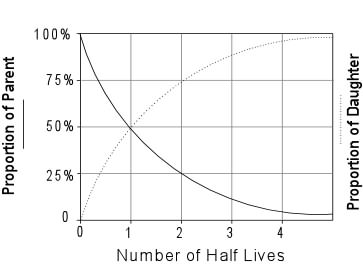 |
After the passage of two half-lives only 0.25 gram will remain, and after 3 half lives only 0.125 will remain etc. |
|
Some examples of isotope systems used to date geologic materials. Note that with the exception of 14C, all techniques can only be used to date igneous rocks. Some elements occur in such small concentration or have such long half lives, that they cannot be used to date young rocks, so any given isotope system can only be used if the material available is suitable for that method. |
Parent |
Daughter |
t1/2 |
Useful Range |
Type of Material |
|
238U |
206Pb |
4.5 b.y |
>10 million years |
Igneous Rocks and Minerals |
|
235U |
207Pb |
710 m.y |
||
|
232Th |
208 Pb |
14 b.y |
||
40 K |
40Ar & 40Ca |
1.3 b.y |
>10,000 years |
|
|
87Rb |
87 Sr |
47 b.y |
>10 million years |
|
| 14C | 14N | 5,730 y |
100 - 70,000 years |
Organic Material |
| Example: Potassium - Argon (K-Ar) Dating
In nature there are three isotopes of potassium:
Example - Radiocarbon (14C) Dating |
Other Numeric Age Methods There are other means by which we can determine numeric age, although most of these methods are not capable of dating very old materials. Among the methods are:
|
| Absolute Dating and the Geologic Column |
| Using the methods of absolute dating, and cross-cutting relationships of igneous rocks, geologists have been able to establish the numeric ages for the geologic column. For example, imagine some cross section such as that shown below. |
|
|
|
From the cross-cutting relationships and stratigraphy we can determine that:
By examining relationships like these all over the world, numeric age has
been very precisely correlated with the Geologic Column. But, because the geologic
column was established before radiometric dating techniques were available, note that the
lengths of the different Periods and Epochs are variable. |
|
The Age of the Earth Theoretically we should be able to determine the age of the Earth by finding and dating
the oldest rock that occurs. So far, the oldest rock found and dated has an age of
3.96 billion years. Individual zircon grains in sandstones have been dated to 4.1 to 4.0 billion years old. But, is this the age of the Earth? Probably not,
because rocks exposed at the Earth's surface are continually being eroded, and thus,
it is unlikely that the oldest rock will ever be found. But, we do have clues about
the age of the Earth from other sources:
Summary We have now presented most of the tools necessary to interpret Earth history. These tools include knowledge of different kinds of rocks and the conditions under which they form and the laws of stratigraphy. To make sure you have acquired the knowledge necessary to use these tools, make sure you understand how the interpretations were made in the production of the artwork on pages 454-455 in your textbook and figure 12.5. |
|
|
Questions on this material that might be asked on an exam
|